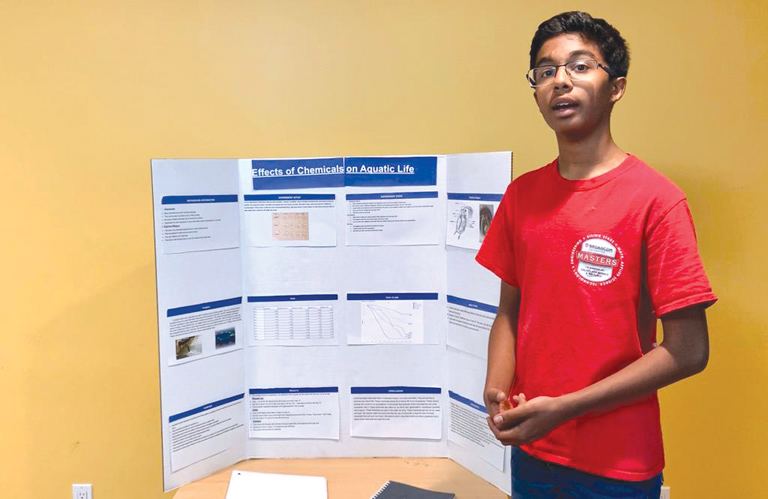
Mahesh Arunachalam, an eighth grader at Rosemont Middle School, won second place in the recent LACSEF. All the judging was done virtually due to COVID-19.
By Lori BODNAR, intern
The 70th annual LA County Science and Engineering Fair (LACSEF) was conducted remotely in virtual format for the first time in its 70-year history due to the COVID-19 global pandemic. Nearly 700 students from over 100 public, parochial and private schools in Los Angeles County participated in the county science and engineering fair held from March 19-21. The LACSEF is one of the oldest and largest regional science fairs in the western United States. The theme for this year’s science fair was “Dig Deep, Discover More.” There were 36 Junior Division (grades six through eight) and Senior Division (grades nine through 12) project categories, ranging from animal biology to engineering to product science. Mahesh Arunachalam, an eighth grader at Rosemont Middle School, won second place in microbiology, junior division at the LACSEF.
“My project was about the effects of harmful chemicals on aquatic life,” said Mahesh. “I was interested in research about aquatic projects, and I found the aquatic crustacean Daphnia magna, a freshwater zooplankton, and I researched it further.”
Daphnia are filter-feeders that are abundant in lakes, ponds and rivers in the Northern Hemisphere where they are commonly called “water fleas.” Their translucent bodies easily reveal their beating heart and they are around 2-5 millimeters in length, so they can be observed without a microscope. Daphnia are the basis of most freshwater aquatic food chains.
“I wanted to test what the effect of common, widely-used herbicides and fertilizers would have on the Daphnia, since they are widespread and a basis of most freshwater aquatic food chains,” explained Mahesh. “There was a toxicity of the herbicides, such as glycophosphate (the main ingredient in the herbicide Roundup), and, to a lesser extent, a toxicity of the urea fertilizer on the Daphnia organisms. In concentration levels typically found in aquatic environments from farming or urban runoff, the herbicides or fertilizer were toxic to the Daphnia, resulting in a lower survival rate compared to the control which was spring water alone without the glycophosphate or urea chemical additives. Usually the lethality would be within just a few days but, at higher concentrations, it was within 10 minutes.”
He further explained that one of the challenges to the project was working with the Daphnia zooplankton.
“Daphnia is a creature, so I had to take care of it and keep it fed and alive,” he said. “The project took a lot of time because of multiple tests for different chemicals and concentrations. My project brings news to the world about the effects of these chemicals.”
Mahesh has been conducting science projects for science fairs for several years dating back to when he was a student at Mountain Avenue Elementary School. In sixth and seventh grade, Mahesh and his friend Mihir Manchikatla designed and tested an improved dust mask with a better fit to ward off air pollution (see the Sept. 20, 2018 CV Weekly). Their new engineering design earned them a second place award in the Environmental Management Junior Division of LACSEF in 2018 and they moved on to compete at the California State Science Fair (CSSF) and the Broadcom MASTERS, where they placed in the top 300 students nationwide. Mahesh said he wants to be a doctor when he is older.
Many students like Mahesh worked numerous hours on their science projects. Unfortunately, due to the spread of the novel coronavirus SARS-COV-2 (which causes COVID-19), both the California State Science Fair and the International Science and Engineering Fair have been canceled. The CSSF was originally going to be held in Exposition Park at California Science Center on April 20-21. The California State Science and Engineering Fair expected over 900 participants from 400 schools who would have presented 800 projects in competition for nearly $70,000 dollars in total awards. The Regeneron International Science and Engineering Fair, which was planned to be held May 10-15 in Anaheim but was canceled, usually has over 1,500 students compete from over 70 countries for over $4 million worth of awards, scholarships, tuition grants, internships and scientific field trips.
Mahesh said he was happy that the LACSEF wasn’t canceled but just revamped so the projects could be judged virtually, allowing the opportunity for all students to present their science projects they had worked on for months. At first, LACSEF was going to cancel the award ceremony and conduct judging in-person, but then the judges moved to have the entire process of student science project presentation and judging all done virtually.
“I recorded a video of me explaining my project, did a report, and sent photos of my report and poster board for the judging process,” said Mahesh. “The judging process was different this year due to the COVID-19 pandemic. The LA County Science and Engineering Fair was all done electronically.”
Mahesh said he is looking forward to receiving his certificate and medal for winning second place in the Microbiology Junior Division in the mail; all certificates, awards and medals are being mailed directly to the winners’ homes since most schools in LA County are closed due to the COV-19 outbreak.
